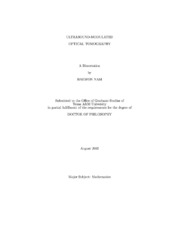Ultrasound-modulated optical tomography
| dc.contributor.advisor | Dobson, David C. | |
| dc.creator | Nam, Haewon | |
| dc.date.accessioned | 2004-09-30T02:01:12Z | |
| dc.date.available | 2004-09-30T02:01:12Z | |
| dc.date.created | 2002-08 | |
| dc.date.issued | 2004-09-30 | |
| dc.identifier.uri | https://hdl.handle.net/1969.1/448 | |
| dc.description.abstract | Ultrasound-modulated optical tomography is modeled by a linear integral equation and an inverse problem involving a diffusion equation in n spatial dimensions, n=2, 3. Based on measured data, the optical absorption coefficient μ is reconstructed inside of a given domain. We make a two-step mathematical model. First, we solve a linear integral equation. Assuming the energy fluence rate has been recovered from the previous equation, the absorption coefficient μ is then reconstructed by solving an inverse problem. Numerical experiments are presented for the case n=2. Two methods are used for the numerical experiments, gradient descent and levelset. At the end, advantages and disadvantages of those two methods are mentioned. | en |
| dc.format.extent | 633426 bytes | en |
| dc.format.extent | 295854 bytes | en |
| dc.format.medium | electronic | en |
| dc.format.mimetype | application/pdf | |
| dc.format.mimetype | text/plain | |
| dc.language.iso | en_US | |
| dc.publisher | Texas A&M University | |
| dc.subject | Inverse Problem | en |
| dc.title | Ultrasound-modulated optical tomography | en |
| dc.type | Book | en |
| dc.type | Thesis | en |
| thesis.degree.department | Mathematics | en |
| thesis.degree.discipline | Mathematics | en |
| thesis.degree.grantor | Texas A&M University | en |
| thesis.degree.name | Doctor of Philosophy | en |
| thesis.degree.level | Doctoral | en |
| dc.contributor.committeeMember | Walton, Jay R. | |
| dc.contributor.committeeMember | Wang, Lihong | |
| dc.contributor.committeeMember | Pasciak, Joseph E. | |
| dc.type.genre | Electronic Dissertation | en |
| dc.type.material | text | en |
| dc.format.digitalOrigin | born digital | en |
Files in this item
This item appears in the following Collection(s)
-
Electronic Theses, Dissertations, and Records of Study (2002– )
Texas A&M University Theses, Dissertations, and Records of Study (2002– )


